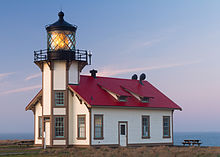Point Cabrillo Light

Point Cabrillo Lighthouse
|
|
|
California
|
|
| Location |
Caspar California United States |
|---|---|
| Coordinates | 39°20′54.97″N 123°49′34.02″W / 39.3486028°N 123.8261167°WCoordinates: 39°20′54.97″N 123°49′34.02″W / 39.3486028°N 123.8261167°W |
| Year first constructed | 1909 |
| Automated | 1973 |
| Foundation | concrete basement |
| Construction | wooden tower |
| Tower shape | octagonal prism tower with balcony and lantern on fog signal building |
| Markings / pattern | white tower, black lantern |
| Height | 47 feet (14 m) |
| Focal height | 81 feet (25 m) |
| Original lens | Third-order Fresnel lens |
| Current lens | Third-order Fresnel lens |
| Range | 22 nautical miles (41 km; 25 mi) |
| Characteristic | Fl W 10s. |
| Admiralty number | G4362 |
| ARLHS number | USA-619 |
| USCG number | 6-0450 |
| Managing agent | Point Cabrillo Lightkeepers Association |
Point Cabrillo Light is a lighthouse in northern California, United States, between Point Arena and Cape Mendocino, just south of the community of Caspar. It has been a federal aid to navigation since 1909. It is part of the California state park system as Point Cabrillo Light Station State Historic Park.
It should not be confused with the inactive Old Point Loma Lighthouse or the active New Point Loma Lighthouse in San Diego, both of which lie within the grounds of Cabrillo National Monument and are sometimes referred to as the Cabrillo lighthouse.
The Point Cabrillo Lighthouse complex is located about 1.5 miles (2.4 km) north of Mendocino, California, and includes the lighthouse itself together with several outbuildings. Most of the original structures remain, but the barn is missing: in 1986 it was destroyed in a fire department exercise. The remaining lighthouse station is "one of the most complete light stations in the United States".
Atop the lighthouse spins a third-order Fresnel lens with four panels containing 90 lead glass prisms and weighing 6800 pounds, constructed by Chance Brothers, an English company, and shipped to Point Cabrillo around Cape Horn. The light is only 32 feet (9.8 m) above the ground, but because of the height of the headlands it stands 81 feet (25 m) above sea level. It was originally lit by a kerosene lamp and turned by a clockwork mechanism but this was replaced by an electric light and motor in 1935. The present light uses a single 1000-watt electric filament. Depending on atmospheric conditions, the Fresnel lens creates a focused beam which can be seen to the horizon and beyond. The beam rotates once every 40 seconds, producing a flash every 10 seconds.
Point Cabrillo, the sandstone headland on which the Point Cabrillo Light lies, was named in 1870 by the United States Geological Survey after the Portuguese explorer João Rodrigues Cabrilho, although Cabrillo's voyage of exploration on behalf of Spain along the California coast did not reach as far north as the point. Because Spain controlled early California, the Spanish derivation of his name is the one used today. The opium-trading brig Frolic wrecked on a reef north of Point Cabrillo in 1850; the investigation of the wreck by agents of Henry Meiggs led to the discovery of the coast redwood forests of the Mendocino area and the beginning of the timber trade that would drive the local economy for decades.
...
Wikipedia

